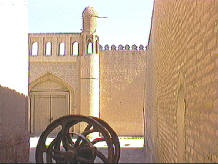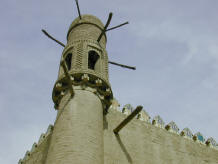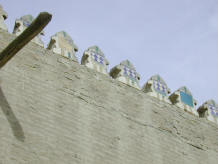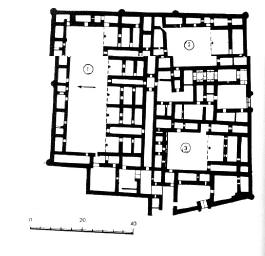The Khan's palace is a large building, ornamented with pillars and domes, which, covered with bright coloured tiles, flash in the sun, and attract the attention of the stranger approaching Khiva. A guard of thirty or forty men armed with scimitars stood at the palace gates. We next passed into a small courtyard. the Khan's guards were all attired in long flowing robes of various patterns, bright coloured sashes being girt around their waists, and tall fur hats surmounting their bronze countenances. The courtyard was surrounded by a low pile of buildings, which are the offices of the palace, and was filled with attendants and menials of the court. Good looking boys of effeminate appearance, with long hair streaming down their shoulders, and dressed a little like women, lounged about, and seemed to have nothing in particular to do.
Captain Fredrick Burnaby "A Ride to Khiva" 1876





There were two gates into the palace. The main gate was for visitors, such as official guests and local citizens intending to petition the Khan. They would enter through the gate into the main corridor and from here go into the 'Ishrat Hauli' where the Khan received company or the 'Auz Hauli' (literally 'Voice Court') where he dispensed justice. This gate was also used by male relatives of the Khan's harem who were able to meet their veiled daughters or sisters under supervision only at the gate itself. The other gate was for servants and trademen and was situated on the south wall of the palace. A narrow passage runs along outside the palace which is paved with the original uneven stone slabs showing worn grooves of carriage wheels. Today both gates are closed and access to the palace is through a specially built entrance to the harem.




